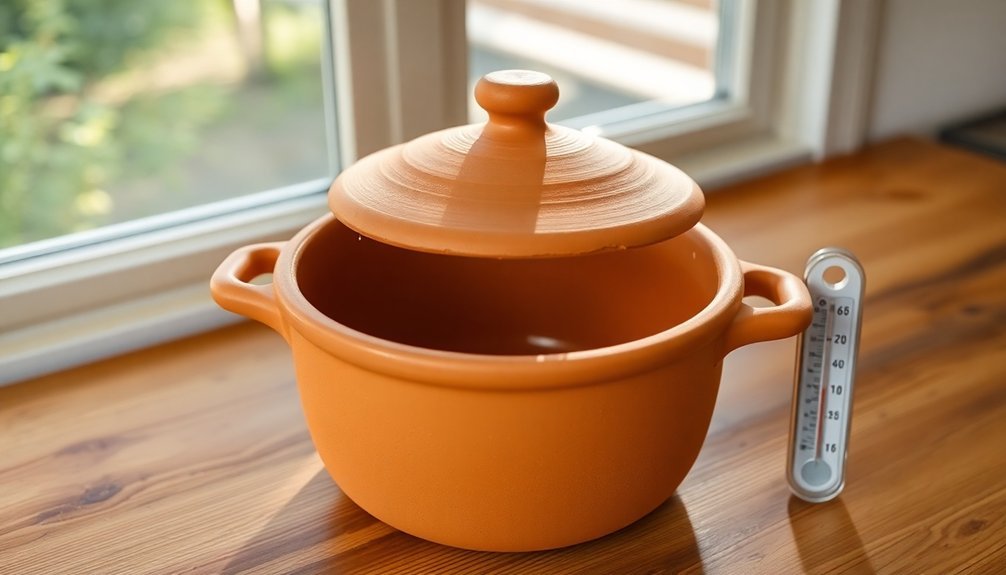To guarantee safe clay pot cooking, you'll want to focus on three key techniques. First, choose unglazed clay pots made from primary clay and verify their purity through manufacturer test results. Second, properly season your pot by soaking it in water for 8 hours, then treating it with either traditional oil-based methods or rice water techniques. Third, store your pots in a shady, well-ventilated area and maintain consistent moisture levels with a damp cloth cover. These fundamental practices will protect your family's health while maximizing your clay pot's natural preservation qualities. Discover how these ancient vessels can transform your cooking experience.
Safe Clay Selection Practices

Choosing the right clay pot can make the difference between safe, nutritious cooking and potential health risks. You'll need to focus on selecting pots made from primary clay, which is naturally free from toxic metals and chemical contamination.
When shopping, don't hesitate to ask manufacturers for test results that verify their clay's composition and purity. Reputable brands like Miriams Earthen Cookware prioritize health standards and material transparency.
Look for pots that maintain a deep red color throughout and avoid those with glossy finishes or colorful glazes, as these often contain harmful chemical additives. You should also check for white, gritty spots that indicate lime impurities.
A high-quality clay pot will produce a clear ringing sound when tapped and won't scratch or flake easily.
To guarantee durability, select pots that have been kiln-fired at high temperatures, resulting in dense, ceramic-like walls. The pot's surface should be completely unglazed and free from additives like iron oxide, petalite, or lime.
You'll want to verify that the manufacturer provides full disclosure of their clay's composition, as transparency is a key indicator of a trustworthy product.
Natural Pot Seasoning Methods
Breaking in your clay pot properly sets the foundation for years of safe and successful cooking. You'll need to begin with an 8-hour water soak to remove impurities, followed by a thorough cleaning using natural agents like baking soda or gram flour – never soap, which can penetrate the clay.
After drying your pot, you'll want to season it using one of these proven methods:
| Step | Traditional Method | Alternative Method |
|---|---|---|
| 1 | Rub cooking oil all over | Fill with rice water overnight |
| 2 | Heat oil and sauté onions | Boil rice water in pot |
| 3 | Apply thin oil layer outside | Cook rice porridge inside |
| 4 | Let oil absorb completely | Allow to cool completely |
| 5 | Repeat if needed | Discard water and dry |
Regular seasoning helps maintain pot durability and enhances the flavors of dishes cooked in it.
You can strengthen your pot further by creating a flour-water mixture and heating it until bubbling, or by using coconut refuse as a natural seasoning agent. For best results, cook water-based recipes 3-5 times consecutively after initial seasoning. Remember to clean the lid using the same methods if your pot includes one.
Proper Storage Techniques

Once you've seasoned your clay pot properly, storing it correctly will guarantee its longevity and peak performance. Place your cooler in a shady, well-ventilated area away from direct sunlight to maintain ideal cooling efficiency.
Make certain there's adequate air circulation around the pot, as this is vital for the evaporative cooling process. Keep the sand layer between the pots consistently moist, adding water daily as needed. This simple technique can reduce temperatures significantly, lowering them by 10-15 degrees Celsius compared to the surrounding air.
Cover the cooler with a damp cloth folded several times, but remember to squeeze out excess water to prevent oversaturation. You'll need to monitor moisture levels regularly to maintain effective cooling.
When storing food, use only clean, dry fruits and vegetables that are compatible with each other. Don't mix ethylene-producing fruits with other produce, and avoid storing items that rot easily in humid conditions, such as carrots and sweet peppers.
Arrange the contents to allow proper air circulation within the inner pot. Clean your cooler regularly to prevent contamination, and maintain a dust-free environment around it.
Don't use the pot for storing meat, dairy products, medicines, or vaccines, as these items require different storage conditions.
Frequently Asked Questions
Can Clay Pots Be Used on Induction Cooktops?
Yes, you can use clay pots on induction cooktops. If you've got a flat-bottomed pot, use it directly after seasoning. For round-bottomed pots, you'll need an induction converter disk or heat diffuser.
How Do You Fix Hairline Cracks in a Clay Pot?
You'll need to clean the crack with water and baking soda, score it slightly deeper, then fill it with clay slip or paper clay mixture. Compress the area with a smoothing stone and let it dry completely.
Is It Safe to Refrigerate Food Directly in Clay Pots?
While you can refrigerate food in clay pots, it's better to transfer items to glass containers. Clay pots aren't ideal for storing cold foods, and they may develop mold in humid conditions of your refrigerator.
Why Does My Clay Pot Smell Musty After Storing?
Your clay pot smells musty because it's retaining moisture and may have trapped food residues. When you store it without proper drying or ventilation, mold and mildew can develop, causing those unpleasant odors.
Can I Use Clay Pots for Deep Frying?
No, you shouldn't use clay pots for deep frying. They can't handle high temperatures and large amounts of oil safely. The porous material could crack under intense heat, creating dangerous cooking conditions.
In Summary
You'll get decades of safe, delicious meals from your clay pots by following these essential practices. Remember to select food-grade clay pots, season them properly with natural oils and spices, and store them in a dry, well-ventilated space. Don't skip any safety steps – they're vital for preventing contamination and cracks. With proper care, your clay cookware will become a trusted kitchen companion.





Leave a Reply